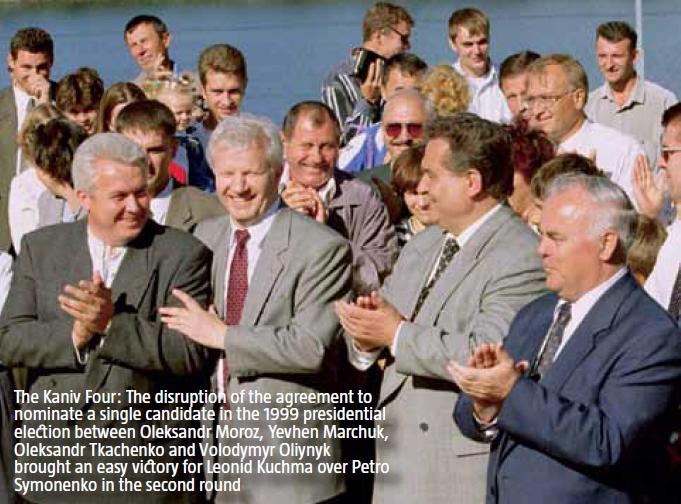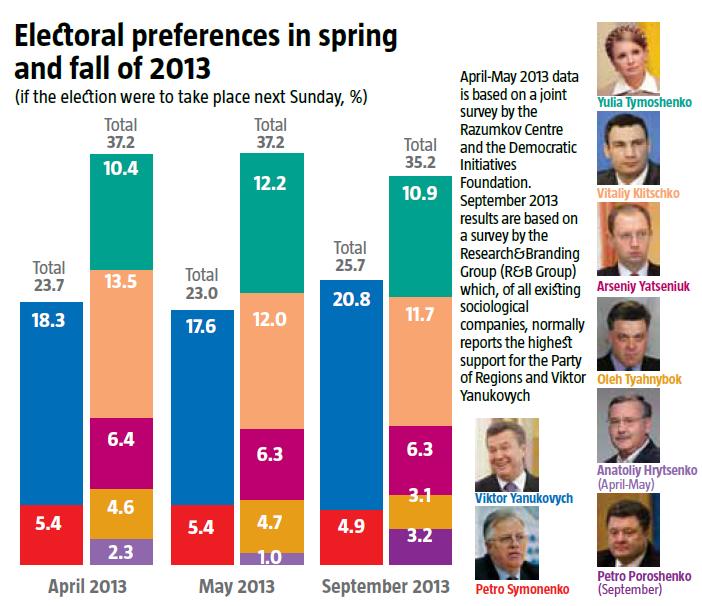The promotion of Viktor Yanukovych’s new image as a European integrator ready to resist Moscow’s pressure continues. The goal is for him to win more voters in Central and even Western Ukraine, where pro-European sentiments prevail. The Party of Regions – fierce opponents of all things Ukrainian and Euro-Atlantic integration in the recent past – is radically changing its rhetoric.
READ ALSO: Target: The President
The media and experts have long buzzed about the Bankova’s[1] plans to repeat the scenario once used by the unpopular President Leonid Kuchma in 1999 for Yanukovych in 2015. Back in 1999, Leonid Kuchma’s popularity was much lower than Yanukovych’s today. However, after Viacheslav Chornovil, a major politician who was expected to run as the main opposition candidate against Kuchma, died in a car crash under suspicious circumstances, and the Kaniv Four[2] fell apart, Kuchma managed to draw the leader of the Communist Party, Petro Symonenko, in the second round. As expected, most Ukrainians fiercely opposed Symonenko – and the “return of the red plague” – so they elected Kuchma. Otherwise, they would never have voted for him.

Unlike Kuchma, Yanukovych has a much wider choice of candidates in a second round. According to sociological surveys, he could win the election in a race against Svoboda’s Oleh Tyahnybok (by fueling the “brown plague” threat) or the Communist Party’s Petro Symonenko.
Any of these scenarios would require Yanukovych to eliminate the most popular candidates at the finish line. There are two options. Today, these most popular candidates are Yulia Tymoshenko, UDAR’s Vitaliy Klitschko and Batkivshchyna’s Arseniy Yatseniuk. According to a survey by the sociological company, Research&Branding Group, Yanukovych would have got 20.8% if the election had taken place at the end of September. Klitschko would have followed with 11.7%, Tymoshenko with 10.9%, Yatseniuk with 6.3%, Petro Poroshenko with 3.2% and Tyahnybok with 3.1%. Overall, this looks similar to the data published in spring by the Razumkov Centre (see Electoral preferences in spring and fall of 2013).
NO MAN – NO PROBLEM
Apparently, those in power will not allow Yulia Tymoshenko to run in the election. News has recently surfaced that Vitaliy Klitschko could also be eliminated from the race because he has not lived permanently in Ukraine for the past 10 years as required by Ukrainian legislation. The Ukrainian Week’s sources claim that UDAR takes this threat seriously and is developing options for counteraction. Experts note that this information could have leaked out because Bankova is not taking this scenario seriously. Otherwise, this plan would have been kept secret until the very last moment. Those in power may also be planning to use this argument against the single opposition candidate in the first round – something fiercely promoted by UDAR members since as the most popular opposition candidate, Klitschko would be that leader – in the first round. Sociological surveys conclude that if he is eliminated from the race, his votes will most likely be distributed between Yatseniuk, Tyahnybok, Poroshenko and Symonenko,. Arseniy Yatseniuk will then get the vote of most of Klitschko’s electorate.
READ ALSO: In Pursuit of the Presidency
The race against Yatseniuk would also mean a defeat for Yanukovych, according to the latest sociological surveys. Therefore, attempts to eliminate Klitschko from the race would be of little benefit for the Presidential Administration: it would automatically boost Yatseniuk’s chances of victory. So far, sociologists have reported that Yanukovych stands the best chance of winning the 2015 election in a race against Oleh Tyahnybok. For that, Yatseniuk has to be squeezed out of the game as well. A standard scheme to do this could be to focus on the conflicts within the united opposition and add to it a wave of mudslinging or accusations that Yatseniuk is cooperating with the government. However, these schemes have already been tested and failed to give the desired effect. A wide-scale campaign of mudslinging against Arseniy Yatseniuk may now have the opposite effect and push him to the second round as a candidate persecuted by those in power. A more certain way would be to launch a trial and put him in jail. However, this is an unlikely extreme scenario given its risk to Yanukovych’s image. He still does not know how to solve the poorly orchestrated situation around the imprisonment of Tymoshenko.

So, virtually the only effective mechanism to eliminate Yatseniuk and Klitschko from the game simultaneously is to talk Yatseniuk into supporting Klitschko in the first round in exchange for, say, the premier’s office in a parliamentary republic. After this, Klitschko may be kicked out of the race based on the abovementioned legal provision. This could happen late enough to leave too little time for Yatseniuk to register as a candidate for the presidency. As a result, Oleh Tyahnybok would remain the only eligible candidate of the top four opposition leaders. In spring, when Ukraine buzzed about the scenario of Yanukovych versus Tyahnybok, the latter insisted that “any opposition candidate in the second round will be supported by the entire opposition”. However, sociologists confirm that a large part of Klitschko’s and Yatseniuk’s electorate will again vote with their feet or against all in the second round if those in power fuel the “brown plague” hysteria around Tyahnybok, especially in South-Eastern and Central Ukraine.
READ ALSO: Language Myths in Eastern and Southern Ukraine
ATOMIZING THE OPPOSITION
The biggest risk for the opposition – and the biggest chance for those in power – is the first round. This is where the regime may implement a scenario that will make massive falsification in the final round unnecessary and prevent anything like Orange Revolution. Moreover, it does not require the elimination of the most popular opposition candidates or Yulia Tymoshenko. The scenario is to dilute votes among numerous opposition candidates as much as possible and minimize their chance to even get to round two. It is possible to project now that the ballots will include such people as Petro Poroshenko, Anatoliy Hrytsenko, Viacheslav Kyrylenko, Viktor Yushchenko, Mykola Katerynchuk and other unpopular candidates that may still steal the leaders’ votes. A young and promising candidate like Serhiy Tihipko may pop up right before the election.
United, the opposition electorate outweighs that of Yanukovych. But fragmented between 10-12 candidates with ratings of over 1%, including 4-5 with potential support of more than 5% (Tymoshenko, Klitschko, Yatseniuk, Tyahnybok and Poroshenko), it will leave much fewer chances for candidates promoting themselves as the government’s opponents to get to the second round. As a result, Yanukovych could end up running against communist Symonenko, forcing the voters to once again choose between two evils. Should this happen, the current rebranding of Yanukovych as a pro-European politician who has withstood Russian pressure, will play a decisive role in his race against the “Kremlin’s puppet” and the “ghost from the past”, Petro Symonenko.
READ ALSO: Kremlin-imposed “Ukrainian choice”
Currently, Symonenko’s personal rating is way lower than that of Klitschko, Tymoshenko or Yatseniuk. However, the campaign to dilute opposition voters among political outsiders is not in full swing yet. And, if they have no alternative, most Soviet-Russian voters, disappointed with the pro-European Yanukovych, will have to vote for Symonenko. Sociologists report that the Party of Regions’ voters mostly opt for the Communist Party as their second preference and Symonenko as an alternative to Yanukovych. Many voters who supported Yanukovych and the Party of Regions in 2004-2006 had previously churned high ratings for the Communist Party and Symonenko in 1998, 1999 and 2002. Now, when they no longer see Yanukovych as a president worthy of their trust and support, the opposite is likely to occur.
After all, the Communist Party gained 13% in the 2012 parliamentary election. This was unexpectedly high, even despite the administrative leverage used by the Party of Regions in their core regions to gain a majority for itself. In the first round, those in power may not need to press the Communists hard, since Yanukovych will be fine with a considerable gap between himself (24-25%) and Symonenko (15-16%). Under the best-case scenario, the four opposition leaders can get 45-50% together at most in the first round (the remaining 10-15% will be split among outsiders). This means just 11-13% for each of the top four opposition leaders, which hardly guarantees a victory for one of them over Symonenko with his 15%. The same thing happened to the Kaniv Four candidates in 1999.
[1] The Presidential Administration is at Bankova Street
[2] A group of four candidates in the 1999 presidential race made up of Yevhen Marchuk, Oleksandr Moroz, Volodymyr Oliynyk and Oleksandr Tkachenko, who intended to nominate a single most popular candidate in the election. They met to discuss this and call on all candidates to lead a fair campaign in Kaniv, Cherkasy Oblast, hence the name

